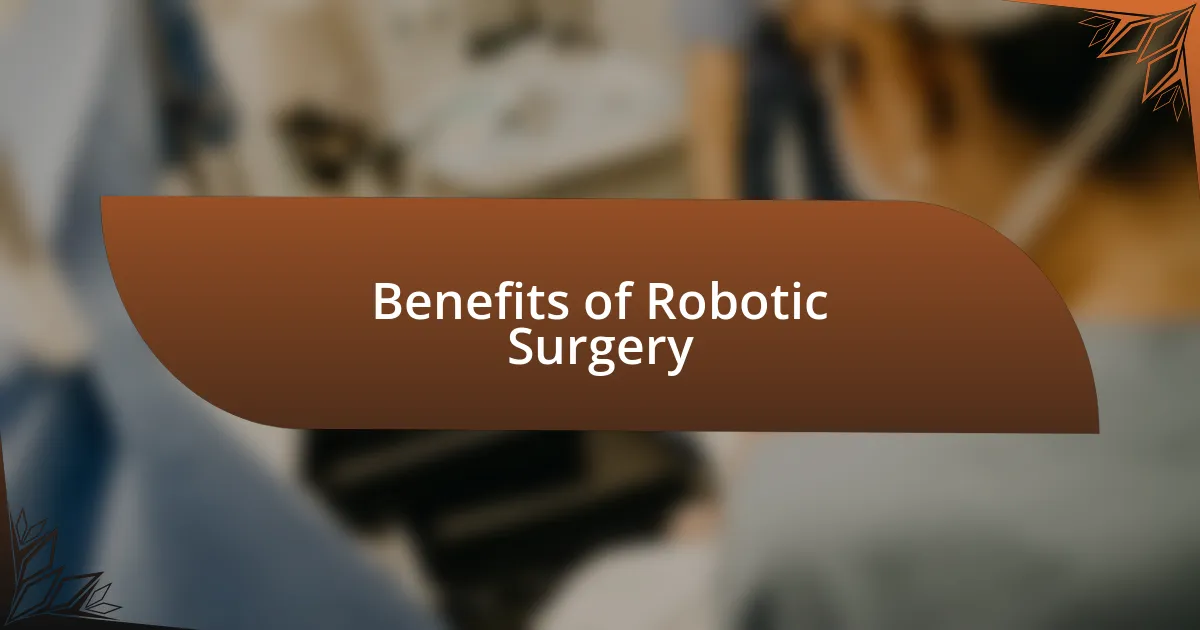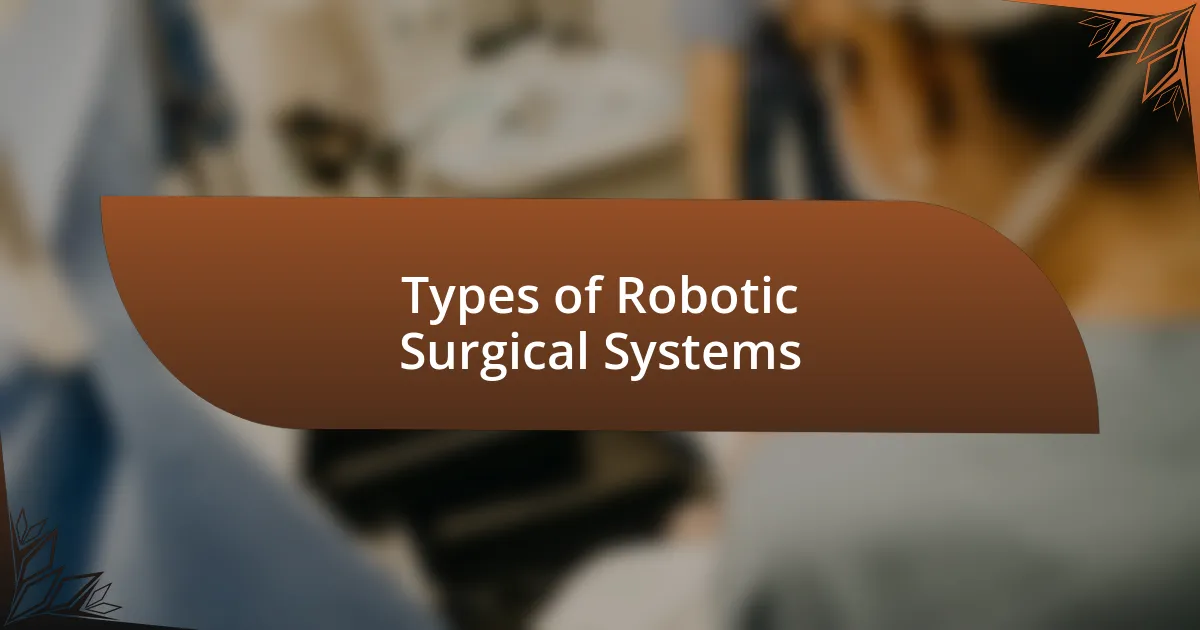
How I Saw Robotics Transform Surgery
Key takeaways:
- Robotic surgery enhances precision and reduces recovery time, transforming patient care experiences.
- Different robotic systems, like da Vinci, MAKO, and ROSA, specialize in various surgical fields, showcasing versatility and improved outcomes.
- Challenges include high costs, the need for extensive training, and limitations in adaptability during complex procedures.
- Future trends indicate the integration of AI, development of smaller robotic systems, and the rise of remote tele-surgery, expanding access to specialized care.

Understanding Robotics in Surgery
Robotics in surgery is an exciting intersection of technology and healthcare that revolutionizes how we approach complex procedures. I remember the first time I saw a robotic surgical system in action; it was both awe-inspiring and a bit unsettling. How can machines assist in intricate operations while ensuring patient safety?
The precision of robotic arms allows surgeons to perform delicate tasks with enhanced accuracy, reducing the risk of complications. During one procedure I observed, the surgeon operated while seated at a console, translating their hand movements into meticulous maneuvers inside the patient’s body. It made me wonder, could this technology eventually outperform the human touch?
As these robotic systems continue to evolve, they offer the potential for minimally invasive techniques that lead to quicker recovery times. I’ve seen patients leave the hospital days earlier than traditional methods would allow, and the joy in their faces truly highlights the transformative power of robotics in surgery. Isn’t it fascinating how innovation can lead to such profound improvements in patient care?

Benefits of Robotic Surgery
The benefits of robotic surgery are vast and multifaceted. One of the most striking advantages I’ve observed is the reduction in recovery time. For example, I recall a time when a close friend’s father underwent robotic-assisted prostate surgery. He was up and walking the very next day, a stark contrast to the weeks of recovery usually required after traditional surgery. This not only accelerates the healing process but also diminishes the time patients spend in the hospital, an experience I find quite comforting.
Here are several key benefits of robotic surgery:
- Minimally invasive techniques lead to smaller incisions, which can reduce pain and scarring.
- Enhanced precision allows for more complex procedures with fewer complications.
- Shorter hospital stays mean less disruption to the patient’s life and reduced healthcare costs.
- Less blood loss during operations, promoting safer recovery.
- Improved visualization through advanced imaging, offering surgeons a better view of the surgical field.
As I reflect on these advantages, I feel a deep sense of optimism about the future of surgical care. Robotic technology doesn’t just enhance surgical precision; it fundamentally redefines the surgical experience for patients and their families, creating a more hopeful journey toward recovery.

Types of Robotic Surgical Systems
When discussing robotic surgical systems, it’s fascinating to see how diverse the options are, each designed for specific surgical procedures. For instance, the da Vinci Surgical System is one of the most recognized platforms, primarily utilized for urological and gynecological surgeries. I remember attending a workshop where a surgeon demonstrated its precision, moving instruments in ways that human hands simply cannot, which left a lasting impression on me regarding its capabilities.
On the other hand, there’s the MAKO system, which stands out in orthopedic surgery. I once shadowed an orthopedic surgeon using this technology for knee replacement. It was incredible to witness how the system allowed for personalized surgery, tailoring the procedure to the patient’s unique anatomy. The enthusiasm in the room was palpable as everyone recognized the potential for improved outcomes.
Lastly, the ROSA robot specializes in neurosurgery, showcasing the adaptability of robotic systems in varied medical fields. I can’t forget how a neurosurgeon explained the importance of stability and precision in brain surgery. Watching the ROSA robot assist during this delicate procedure underscored how far technology has come in making surgeries safer and more effective.
| Robotic System | Specialization |
|---|---|
| da Vinci Surgical System | Urological and Gynecological Surgeries |
| MAKO Surgical System | Orthopedic Surgeries |
| ROSA Surgical System | Neurosurgery |

Real-World Applications in Surgery
Witnessing robotic systems in action has been nothing short of transformative for surgical procedures. I’ll never forget observing a minimally invasive prostatectomy using the da Vinci system. It was astonishing how the surgeon controlled the robot with such finesse, making precise maneuvers while reducing the patient’s recovery time significantly. Don’t you find it remarkable how technology not only enhances surgical precision but also elevates patient care?
In another instance, I saw the MAKO system being used to assist in a complex hip reconstruction. The surgeon explained that it allowed for 3D modeling of the patient’s original joint, leading to a more customized approach. I was struck by the palpable sense of collaboration between the robot and the surgical team. It felt as if the technology was not just an assistant but a vital partner in achieving the best possible outcome. Can you imagine how comforting it must be for patients to know their surgery is personalized this way?
Then there was the moment watching ROSA in a neurosurgical setting that truly stuck with me. As the neurosurgeon guided the robot amid delicate brain tissue, I could see the level of concentration and confidence in the team’s faces. The precision the robot brought to the procedure was palpable, reducing the risk of complications. How amazing is it that technology can facilitate such intricate work while ensuring patient safety? Each of these experiences reinforced my belief in robotics as a game-changer in modern surgery, not just for surgeons but for patients as well.

Challenges and Limitations
When considering the challenges of robotics in surgery, the high costs associated with procuring and maintaining these advanced systems can be daunting. From my perspective, I have seen hospitals hesitate to adopt robotic technology due to budget constraints, which ultimately affects patient access to cutting-edge care. Isn’t it frustrating that such revolutionary tools may not be available to all patients simply because of financial limitations?
Moreover, there’s the issue of steep learning curves for surgical teams. During my observations, I noted how essential it is for surgeons to undergo extensive training to operate robotic systems effectively. I remember talking to a resident who felt overwhelmed during her initial attempts with a robotic platform. This situation illustrates a critical challenge: while the technology is impressive, mastering it requires significant investment in time and effort. How can we ensure that the next generation of surgeons becomes proficient without sacrificing patient care?
Lastly, I’ve observed that robotic systems can sometimes face limitations in adaptability during complex procedures. During one surgery I witnessed, the surgeon had to switch to traditional techniques midway because the robot couldn’t accommodate an unexpected anatomical variation. It struck me how reliance on technology can lead to complications if the human element—the surgeon’s intuition and experience—is not taken into account. Can we find a balance that maximizes the benefits of robotics while preserving essential surgical skills?

Future Trends in Surgical Robotics
Looking ahead, I see a significant trend in the integration of artificial intelligence with surgical robotics. From my observations, AI can enhance decision-making processes in real time, allowing robotic systems to adapt to a surgeon’s movements and refine their precision. Imagine a future where robots do not just follow commands but also assist in predicting potential complications during surgery—how much more safe could that make procedures?
Another exciting avenue is the development of smaller, more versatile robotic systems. I’ve noticed that engineers are designing instruments that can fit into tight spaces and handle delicate operations. This could lead to less invasive surgeries, which I believe is a game changer for patient recovery times. Isn’t it fascinating to think about how advancements in miniaturization could revolutionize surgical techniques?
Finally, the trend toward remote and tele-surgery is on the rise. I remember a webinar I attended that showcased how surgeons could operate robotic systems from thousands of miles away. This could not only expand access to specialized care for underserved regions but also allow for collaboration among experts globally. What possibilities arise when a skilled surgeon can lend their expertise anywhere in the world?




